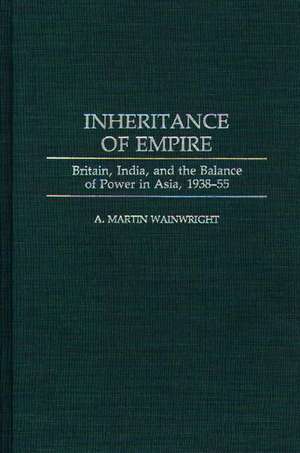Inheritance of Empire: Britain, India, and the Balance of Power in Asia, 1938-55
Autor A Martin Wainwrighten Limba Engleză Hardback – 22 noi 1993 – vârsta până la 17 ani
Preț: 462.45 lei
Preț vechi: 609.32 lei
-24% Nou
Puncte Express: 694
Preț estimativ în valută:
88.49€ • 92.40$ • 73.07£
88.49€ • 92.40$ • 73.07£
Carte tipărită la comandă
Livrare economică 15-29 aprilie
Preluare comenzi: 021 569.72.76
Specificații
ISBN-13: 9780275947330
ISBN-10: 0275947335
Pagini: 256
Dimensiuni: 156 x 235 x 19 mm
Greutate: 0.54 kg
Ediția:New.
Editura: Bloomsbury Publishing
Colecția Praeger
Locul publicării:New York, United States
ISBN-10: 0275947335
Pagini: 256
Dimensiuni: 156 x 235 x 19 mm
Greutate: 0.54 kg
Ediția:New.
Editura: Bloomsbury Publishing
Colecția Praeger
Locul publicării:New York, United States
Notă biografică
A. MARTIN WAINWRIGHT is an Assistant Professor of History at the University of Akron.
Cuprins
ChartsAbbreviationsAcknowledgmentsIndependence and DefenseThe Arsenal Of Empire, 1938-45The Indian Arsenal, the British Empire, and the Western AllianceIndia and Imperial Defense before the Second World WarThe Imperial ArsenalThe Western Alliance's Eastern ArsenalThe Alienation of IndiaThe Nationalist MovementThe MilitaryThe Business CommunityIndia's Potential for PowerThe Limits of ExpansionDefense ProductionSupporting IndustriesThe Transfer of Military Power, 1945-49Indian Unity and the Commonwealth AllianceAnachronisms in British Defense PlanningPartition and Commonwealth DefenseThe Partition of India's Defense ResourcesThe Problem of PartitionThe Collapse of Indian Military UnityBritain and the Origins of the South Asian Arms RaceCommunal Violence and the Kashmir ConflictThe Indo-British Sterling ImbalanceThe South Asian Military ImbalanceThe First Phase of the South Asian Arms RaceIndia's Nuclear Resources and the Status of TravancoreTravancore's Nuclear Resources and Indian UnityIndia's Nuclear Program and the Cold WarAlternatives for British Strategy in the EastIndia's Withdrawal from Commonwealth DefenseThe Search for AlternativesThe Decline of British Military Power East of SuezThe Third Power in Asia, 1949-55India as a Third ForceIndia's Defense PrioritiesPriorities Competing with Defense ProductionHigh-Technology Defense IndustriesThe New Indo-British RelationshipThe United States' Role in the Indo-British RelationshipThe Korean War and the Indo-British Arms TradeThe Cold Wars in South AsiaIndia and the United States-Pakistan AllianceBritain's Role in Indian Defense Production during the 1950sAlternatives to British ArmamentsThe New Indo-British Arms TradeThe New Balance of Power in AsiaAppendicesPrincipal Indian Munitions FactoriesRailway WorkshopsComparable Strengths of Armed Forces of India and Pakistan, 1958Bibliography















